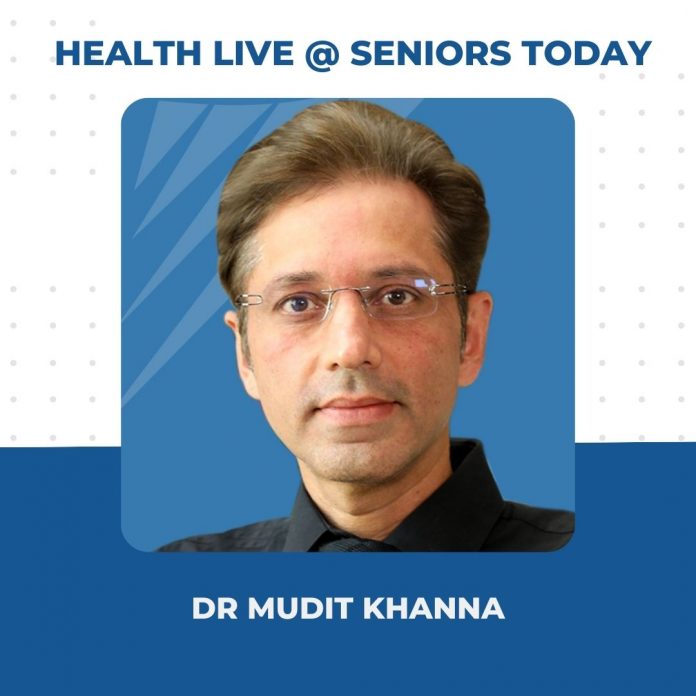On Feb 19, 2022, Seniors Today hosted another one of its weekly Health Live Webinars; our guest for this week was Dr Mudit Khanna who is a leading Consultant – Orthopaedics, Trauma and Joint Arthroplasty (Joint replacement surgery) with the Wockhardt Hospitals, Mumbai.
Dr Khanna graduated from the prestigious King George Medical College from Where he completed both his M.B.B.S, and M.S. in Orthopaedic Surgery. Most of his higher surgical training in Orthopaedic Surgery has centred around gaining expertise in the field of joint replacement surgery in in the United Kingdom and other reputed centres across Europe, USA and Australia. While pursuing his higher surgical training in the field of Orthopaedic Surgery in the United Kingdom for a period of five years in various capacities, he completed his M.R.C.S. from the Royal College of Surgeons of Edinburgh, U.K, and M.Ch. in Orthopaedic Surgery from University of Dundee, Scotland, UK. He has worked as a Senior Clinical Fellow at the Queen Elizabeth Hospital, UK and was awarded the Asia Pacific Zimmer Fellowship, which he pursued at the renowned Cleveland Clinic, Ohio, USA. He has an expertise at performing all forms of primary and revision joint replacement cases and is a trusted name at handling complex sports related injuries requiring arthroscopic treatment.
Dr Khanna has a number of national and international publications and presentations to his credit. He is also extensively into teaching and is faculty across several training programmes aimed at aspiring arthroplasty surgeons. He has authored two highly cited books in the field of postgraduate studies. His work has been acknowledged by leading medical publishers including Reed Elsevier, India and Jaypee Publishers, India.
He is a member of the Royal College of Surgeons of Edinburgh, U.K. and the Indian Orthopedic Association.
The knee is made up of 2 bones- the thigh bone or the femur and the shin bone or the tibia. The joint is the area that lies between the two bones. At the end of the bone, where 2 bones meet to form a joint are covered by a soft cushiony connective tissue that is called the cartilage.
Osteoarthritis is not a problem of the bone, it is a problem of the cartilage that covers the end of these bones.
It is a common term used for both early and advanced stages of the disease.
Our objective is to delay the progression of the arthritis from grade I to grade IV (that is bone on bone arthritis) where the only treatment modality left is surgical.
Osteoarthritis is very common, one in 2 individuals have it over the age of 70
And 2 in 3 people have it in case on overweight or obese individuals over the age of 70
Symptoms of osteoarthritis:
- The primary symptom of osteoarthritis is pain. In the beginning, this pain is typically seen only during certain times of the day and not throughout the day.
Initial symptoms also include- when an individual is seated in one position for a long time, and then they get up, you can have pain for the first few steps and then it gradually gets better.
- Deformity: There are 2 kinds of deformities that we see in the knee. The knocked knee or the bow legs- this depends on which part of the cartilage is worn out.
If the inner part of the knee wears out, the deformity that develops is bow legs.
If the outer part of the knee wears out, the deformity so caused is knocked knees.
- Instability of the knee joint on clinical examination
The only investigation required to diagnose osteoarthritis is a knee X-ray
There is no magic medication to treat osteoarthritis. It is a wear and tear degenerative process.
Prevention of progression of osteoarthritis is the best treatment strategy for treating arthritis.
Once someone develops bone on bone arthritis, the only way out is a surgical treatment which is called a total knee replacement.
You can consider a joint replacement surgery when
- The X ray shows bone on bone arthritis, complete loss of cartilage and we can see bone rubbing on bone.
- There should be a significant amount of pain that affects his day to day life and activities.
It is important that you keep moving your joints, and not just your knee joints. You should move around every few minutes, it also helps in lubrication and ensures that your joints are not stiff when you move after a long time.
The daily requirement for Vit D is 1000 Units per day. And we recommend 6000 IU per week- this is to make up for the deficiency and after the deficiency is made up for, it’s 1000 units per day
Half an hour in the early morning sun should also suffice.



